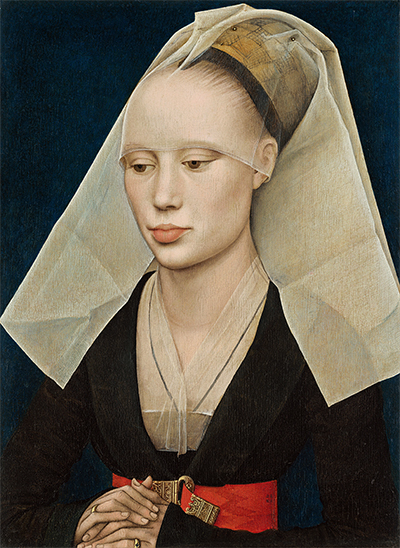Rogier van der Weyden was one of the three famous Netherlandish artists known collectively as the Flemish Primitives, alongside Jan van Eyck and Robert Campin.
His oeuvre was varied, both in medium and style. Most recent publications on his career have concentrated almost exclusively on his paintings but he was actually highly skilled as a draughtsman and sculptor too. Each and every element of his career is addressed in this extensive website.
Our knowledge of the early years of Rogier van der Weyden's life are patchy in terms of documentation but crucially we do know that he joined the studio of Robert Campin at the age of around 27. Up to that he is considered to have been a bit of an unfulfilled talent, a talent that would finally be released by his training under the wing of another famous name from this period, namely Campin. That said, the earliest works that we can confidently attribute to Rogier van der Weyden bears most the hallmarks of influence from Jan van Eyck.
For many centuries there were paintings from this period that were attributed to the unidentified figure of the Master of Flemalle.
Netherlandish artists, plus those of the Northern Renaissance and Dutch Golden Age have produced amongst the most influential art in European history. Only Italy can claim to have matched, possibly surpassed, the impact of the Flemish regions over a number of centuries. For many years Rogier van der Weyden was actually seen as more talented and respected than Jan van Eyck though his popularity wained for many years after his early impact started to fade. In recent years there has been a return to prominence of his work and he is now mentioned again in the same breath as all the other great masters from this region in Northern Europe.
Rogier van der Weyden was certainly most similar to Van Eyck in artistic style but some of the other notable artists of around this period include the likes of Pieter Bruegel who was part of a family dynasty which captured scenes of peasant life, often spread across sprawling landscape scenes. As a result of that, Pieter the Elder would become known as Peasant Bruegel, with his son following in his footsteps but mainly just living off his father's innovations.
Whilst leaving behind a particularly small ouevre, there can be no doubt that Vermeer should be considered to be amongst the finest European painters in history, with him being most famous for capturing indoor scenes of domestic life in and around his home in Delft. It was particularly the detail and precision of his portraits that captured the imagination and marked him out as one of the key contributors to artistic development.
The master of light and self-portraits was Rembrandt van Rijn, someone who produced dramatic depictions which communicated emotion directly from the artist to the viewer. This artist was fiercely ambitious, constantly studying and even purchasing the work of other artists across Europe in order to absorb as many ideas and technical innovations as possible into his own work. In fact, he became so obsessed with collecting that he was forced into producing huge numbers of artworks for the private market in order to provide finance for his ever-expanding collection.
Northern Renaissance powerhouse, Albrecht Durer, joined the Dutch with his own Nuremburg-based brilliance. This artist specialised in etchings, woodcuts, drawing and painting, producing a huge collection of work across his lifetime. Durer was such a diverse artist, even with a single medium he would tackle a mixture of different genres such as still life, allegorical, mythological, portraits and landscape scenes.
The Netherlands has always been a true maritime nation and many of its famous artists would travel across Europe in order to learn more about other region's art and potentially add some of these influences into their own work. Hans Holbein the Younger, in a sense, did something similar although he was from Germany originally. Netherlandish is clearly apparent throughout his portrait paintings but he would take these skills abroad to Switzerland, France and England. This helped to spread the Dutch influence even further around the continent.




